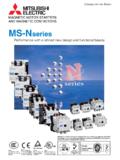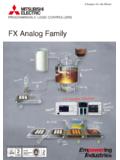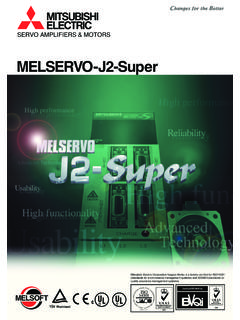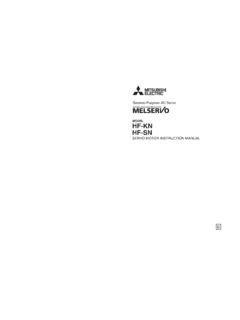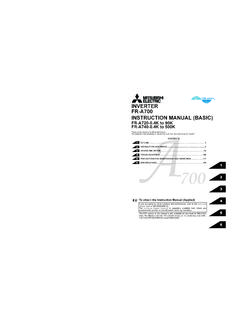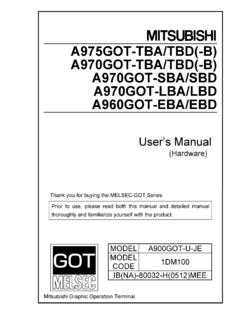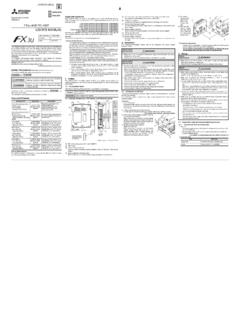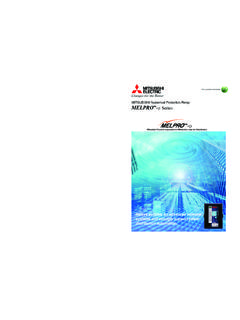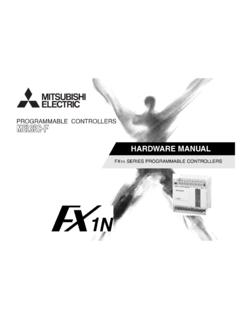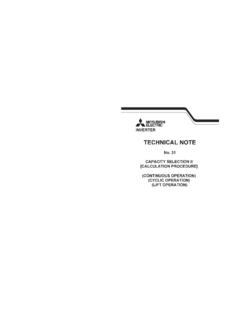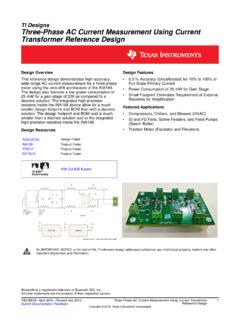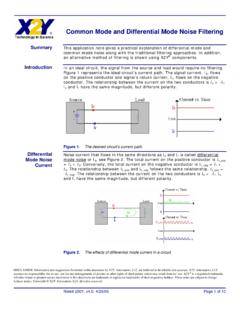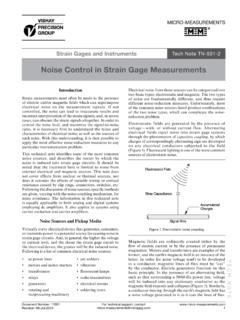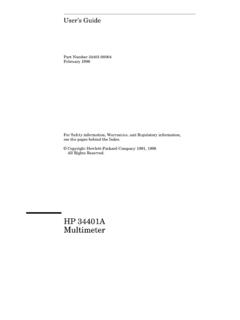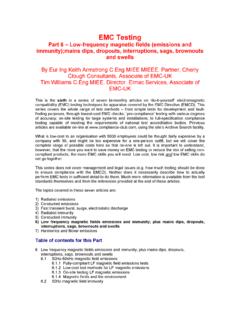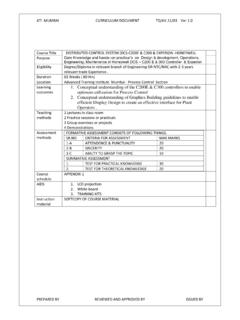Transcription of TECHNICAL NOTE No. 28 - Mitsubishi Electric
1 INVERTER TECHNICAL NOTE No. 28 INVERTERSH-3165 ENG-E(1108)Specifications subject to change without notice. COMPLIANCE OF INVERTERS WITH HARMONIC SUPPRESSION GUIDELINES CONTENTS INTRODUCTION .. 1 1. WHAT IS A HARMONIC? .. 2 Definition of harmonic .. 2 Cause of harmonic generation .. 2 noise and 4 2. INFLUENCE OF HARMONICS .. 5 Influence of harmonics .. 5 Harmonic generating equipment .. 6 Conditions of harmonic 6 Harmonic measurement .. 7 3. HARMONIC GUIDELINES .. 8 Two different harmonic guidelines .. 8 Harmonic guideline relating to inverters .. 8 Household appliance and general-purpose product guideline.
2 8 Specific consumer guideline .. 9 4. EXAMINATION OF INVERTER HARMONICS ACCORDING TO THE SPECIFIC CONSUMER 10 Application of the specific consumer guideline .. 10 Calculation of equivalent capacities of harmonic generating equipment .. 11 Calculation of outgoing harmonic current .. 12 Judgment of harmonic suppression technique 13 5. SPECIFIC CALCULATION EXAMPLES .. 14 Calculation example using calculation sheet (part 1) .. 14 6. HARMONIC SUPPRESSION TECHNIQUES .. 16 Overview of harmonic suppression techniques .. 16 Harmonic suppression techniques on inverter 17 Harmonic suppression technique using power factor improving capacitor.
3 19 Harmonic suppression technique using multi-phased 20 Harmonic suppression technique using AC 21 Harmonic suppression technique using active filter .. 22 7. SPECIFIC GUIDELINE ENFORCEMENT METHODS .. 23 8. QUESTIONS AND ANSWERS .. 24 9. 25 Examination formats .. 25 Inverter-generated harmonic charts .. 27 MEMO 1 INTRODUCTION There were a relatively few instances of harmonics generated in power distribution systems before 1965, as harmonic generation sources were limited to mercury rectifiers, etc. Around 1967, semiconductor application technology progressed remarkably and spread widely into factories, residential buildings and even houses.
4 As a result, the number of occurrences of power system equipment affected by harmonics have increased year by year. This harmonic problem has been examined in various ways by the government. In September 1994, the harmonic suppression guidelines were established by the Ministry of Economy, Trade and Industry (formerly the Ministry of International Trade and Industry) (in Japan). Previously, inverter-induced harmonic malfunctions were not so common and harmonic suppression techniques were mainly used to protect the inverter from harmonics from equipment such as power factor correction capacitors and private generators within the same power distribution system.
5 With the establishment of the guidelines, consumers are advised to suppress outgoing harmonic currents in addition to protect on-site equipment. This TECHNICAL Note shows how to calculate inverter-generated harmonics and how to provide suppression techniques in response to the guidelines. For full information on the selection and usage of harmonic suppression equipment, please contact respective manufacturers. 2 IMCommercialTransistorized inverterConvertercircuitInvertercircuitp owersupplyMotor Fig. Inverter Structure 1. WHAT IS A HARMONIC? Definition of harmonic It is defined that a harmonic has a frequency that is an integral multiple of the fundamental wave (generally the power supply frequency).
6 The composition of a single fundamental wave and several harmonics is called a distorted wave. (Refer to Fig. ) A distorted wave generally includes harmonics in a high-frequency region (kHz to MHz order), but harmonics in a power distribution system are usually of up to 40th to 50th degrees (to several kHz). Harmonics are different in nature from high-frequency problems such as noise and electromagnetic interference. This difference must be made clear. (Refer to Section ) ()iiifnt nonn=+ += 12sin n = 1, 2, 3, .. i : Distorted wave (current) io : DC component it : Fundamental wave component in : Harmonic component (n>2) f = Fundamental frequency (a) Fundamental equation i1i2i3 FundamentalwaveSecond harmonicThird harmonici1i3 CompositionDistorted wave (b) Fundamental wave and harmonics (c) Distorted wave Fig.
7 Distorted Wave Cause of harmonic generation A harmonic source can be any type of equipment where a distorted-wave current flows through an application with a sine-wave commercial-power-supply voltage. The converter circuit (rectifying circuit) of an inverter is no exception. The operation principle of a converter circuit is described below: (1) Operation principle of a converter circuit A transistorized inverter is designed as shown in Fig. to output any frequency to run an induction motor at any speed. Commercial AC power is rectified in the converter circuit to make DC power, which is then converted into any AC in the inverter circuit.
8 3 Motor current (inverter output current)10ms/DIVI nverter input currentFig. Input/Output Current Waveform Measurement Example (50Hz) VNMCCBCED1D2D3D4D5D6 PRInrush current suppression circuitACpowersupplySmoothingcapacitorCo nverter++ Fig. Converter Circuit Fig. shows an input current waveform when DC is made from a single-phase AC supply. Fig. Converter Principle To keep a motor running, energy must be supplied from the power supply as a current. However, current flows into the inverter [I] only while the power supply voltage is higher than the DC voltage [E] that is smoothed with a capacitor. (Period t1 and t2 in Fig.)
9 Because the energy must be supplied in a limited time period, peak currents flow. This peak current causes power supply harmonics. The converter circuit of most transistorized inverters consists of a three-phase full-wave rectifying circuit and a smoothing capacitor as shown in Fig. , and the actual input current waveform is as shown in Fig. As described above, all the rectifying circuits including an inverter circuit can cause harmonics. DC voltage [E] becomes especially high when a smoothing capacitor is connected, allowing a limited time for the power supply. As a result, the amount of peak current increases, and that causes more harmonic currents.
10 CED1D2D3D4 VoltageCurrent I2 VEID1D4 OND3D2 ONt2t1 Invertercircuit(load)AC power supply V 4 noise and harmonics Table Differences between noise and Harmonics of an Inverter and Leakage Current Item noise Power Harmonics Leakage Current Frequency band High frequency (Several 10kHz to 1 GHz order) Normally 40th to 50th degrees or less (3kHz or less) (Several kHz to MHz order) Source Inverter circuit Converter circuit Inverter circuit Cause Transistor switching Rectifying circuit commutation Transistor switching Generated amount Depends on voltage variation ratio and switching frequency Depends on current capacity Depends on switching frequency and voltage Propagation path Electric channel, space, inductionElectric channel Insulating material Transmission amount Distance, wiring route Line impedance Capacitance Affected equipment and influence Sensor, etc.
